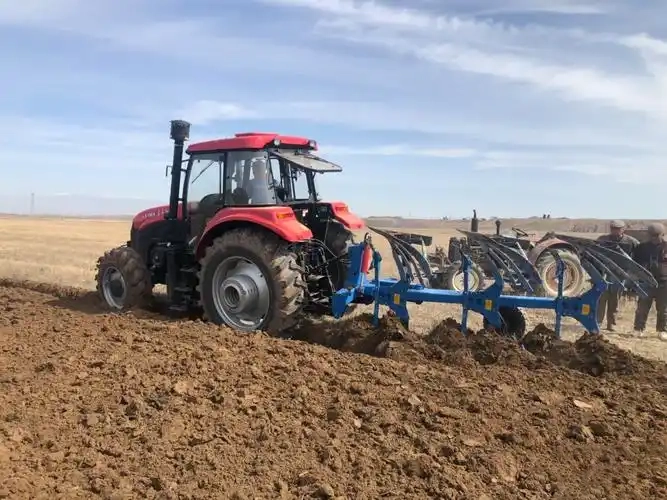Characteristics and body differences between moldboard plows and reversible plows
2025-07-22
The moldboard plow holds a significant position in agricultural production due to its high efficiency, low energy consumption, and excellent crop residue inversion effect. It utilizes a special component called a moldboard to cut and cover the soil, achieving plowing. Moldboard plows are characterized by their simple structure, light weight, ease of operation in small plots, and good soil penetration. Furthermore, their working width is adjustable with multiple gears, adapting to different soil hardness and special conditions. Moldboard plows are also divided into two types: mirror plows and ridged plows, suitable for different geological conditions.

I. Main Characteristics of Moldboard Plows and Reversible Plows
1. Characteristics of Moldboard Plows
Moldboard plows hold an important position in agricultural production due to their high efficiency, low energy consumption, and good crop residue inversion effect. They use a special part called a moldboard to cut and cover the soil, achieving tillage. Moldboard plows have a simple structure, are lightweight, are easy to operate in small plots, and have good soil penetration. In addition, their working width is adjustable in multiple gears, adapting to different soil hardness and special conditions. Moldboard plows are also divided into two types: mirror plows and ridged plows, suitable for different geological conditions.
2. Characteristics of Reversible Plows
Reversible plows are traditional tillage tools that change the structure and properties of the soil by turning it over. Reversible plows can completely overturn the soil, mixing the bottom layer into the surface layer, thus achieving a deep tillage effect. This type of plow is suitable for farmland with a lot of straw because it can completely turn the straw into the soil, facilitating decomposition. In addition, reversible plows also have advantages such as high efficiency, energy saving, multi-functionality, and adjustable depth, suitable for various types of land and crops.
II. Differences in Plow Bodies of Moldboard and Reversible Plows
1. Structural Design Differences
The plow body design of a moldboard plow is relatively simple, mainly consisting of a moldboard and a moldboard beam. The moldboard is the main component responsible for cutting and covering the soil, while the moldboard beam is used to connect to the tractor and other power machinery. In contrast, the plow body design of a reversible plow is more complex, requiring the ability to turn the soil. It usually includes plowshares, plow walls, and a reversing mechanism to ensure that the soil is completely overturned and mixed.
2. Different Working Principles
During use, the moldboard plow tills the soil through the cutting and covering action of the moldboard. When a tractor or other power machinery drives the moldboard plow forward, the moldboard cuts the soil and covers it to the other side, thus completing the tillage process. The reversible plow, on the other hand, completely turns the soil over using a reversing mechanism, mixing the bottom layer into the surface layer. This working principle gives the reversible plow a significant advantage in deep tillage and improving soil structure.
III. Comparison of Applicable Scenarios
Moldboard plows are suitable for rapid tillage operations in small and medium-sized plots. Their flexibility and efficiency make them the preferred choice for many farmers. They are particularly outstanding when quick tillage is needed or when tillage conditions are complex. Reversible plows are more suitable for scenarios requiring deep tillage or soil structure improvement, such as farmland with a lot of straw or where soil fertility needs to be improved. By mixing the bottom layer of soil into the surface layer and burying straw and other organic matter, reversible plows help improve soil structure and increase soil fertility.
Previous:
Related Blog
Autumn is a harvest season, but also a sowing season. While many farmers may have nearly completed their autumn plowing, many others may still be in the process. Whether you have finished or not, today we will discuss rotary tillage and plowing during the plowing process. How to choose the right tillage method? Hopefully, after reading this, you will have less confusion and more understanding.
From plowshare to plow blade: A comprehensive interpretation of the magical power of moldboard plows
The moldboard plow, a marvelous tool in the agricultural field, has played an indispensable role in farmland since its inception. From ancient plowshares to modern, highly efficient plow blades, the evolution of the moldboard plow has witnessed the advancement of agricultural technology. It has not only improved farming efficiency but also laid a solid foundation for stable and high yields of crops. Next, let's step into the world of moldboard plows and fully understand their amazing power.
Contact us
-
Phone:+86-0371-68111999
-
Phone:+86-13526676666
Email:zzkefeng@163.comAddress: Shangjie District, Zhengzhou City, Henan Province


